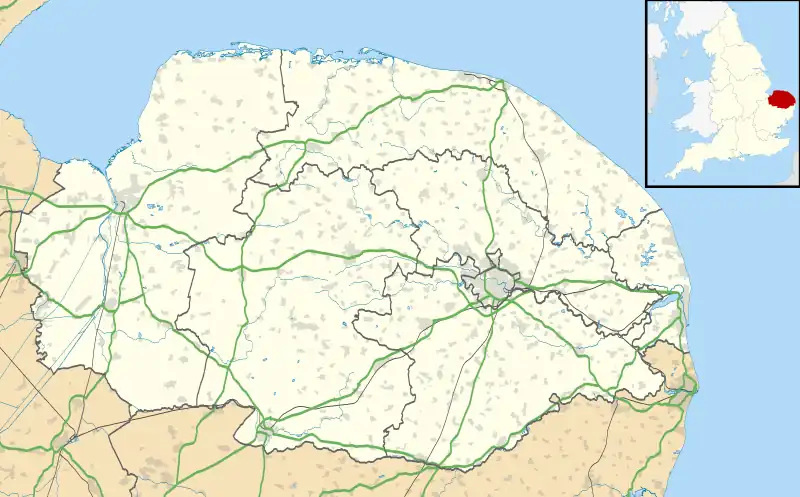Aylsham Town Hall
Aylsham Town Hall is a municipal building in the Market Place in Aylsham, Norfolk, England. The structure, which accommodates the offices and meeting place of Aylsham Town Council, is a grade II listed building.[1]
| Aylsham Town Hall | |
|---|---|
.jpg.webp) Aylsham Town Hall | |
| Location | Market Place, Aylsham |
| Coordinates | 52.7954°N 1.2515°E |
| Built | 1857 |
| Architectural style(s) | Neoclassical style |
Listed Building – Grade II | |
| Official name | Town Hall, Market Place |
| Designated | 1 June 1984 |
| Reference no. | 1306405 |
 Shown in Norfolk | |
History
In the mid-19th century, a group of local businessmen decided to form a company to raise funds for the erection of a corn exchange.[2] The site they selected was on the north side of the Market Place and the foundation stone for the building was laid by the 8th Marquess of Lothian on 6 October 1856.[3] It was designed in the neoclassical style, built in red brick at a cost of £2,100 and was completed in 1857.[4][5]
The design involved an asymmetrical main frontage with nine bays facing onto the Market Place; it involved two distinct sections: a main section of five bays and a right-hand section of four bays which was set back from the main section. The main section contained a central bay, which was slightly projected forward and featured a doorway, accessed by a short flight of steps, which was flanked by Ionic order pilasters supporting a segmental pediment; the central bay was surmounted by a modillioned pediment with a clock in the tympanum. The outer bays in the main section were fenestrated by sash windows with keystones. The right-hand section was also fenestrated by sash windows although the right-hand bay, which was still further set back, was blind. Internally, the principal room was the main assembly hall which contained a queen post roof.[4]
The 6th Battalion of the Norfolk Rifle Volunteers, which was raised on 23 September 1859,[6] used the building as its drill hall[7] and petty session hearings were held there once a fortnight in the 19th century.[8] The building was extended to the west to create additional office space in 1892.[4][9] Following a collapse in corn prices, the company which had developed the building got into financial difficulties: a local solicitor, William Forster, acquired the building and the company was wound up in 1893.[10]
The building was the venue for important public events and, in 1899, it hosted the declaration of the result for the 1899 North Norfolk parliamentary by-election which was won by the Liberal Party candidate, Sir William Gurdon.[11] After Forster's death in 1906, the building was acquired by the local parish council[12] and Sir Oswald Mosley held a gathering of the British Union of Fascists there in 1939.[13]
Following local government re-organisation in 1974, the town hall became the home of Aylsham Town Council.[14][15] A refurbishment of some of the facilities in the town hall was completed in March 2018.[16] Items of interest in the town hall include a collection of material relating to the locally-born pioneer of anaesthesia, Joseph Clover.[17]
References
- Historic England. "Town Hall, Market Place (1306405)". National Heritage List for England. Retrieved 26 February 2022.
- White, William (1864). History, Gazetteer and Directory of Norfolk, and the City and County of the City of Norwich. W. White. p. 663.
- Mackie, Charles. "Norfolk Annals 1851–1900". p. 55. Retrieved 26 February 2022.
- Pevsner, Nikolaus; Wilson, Bill (2002). Norfolk 1 Norwich and North East (Buildings of England Series). Yale University Press. p. 367. ISBN 978-0300096071.
- "Public meeting on future of Aylsham Town Hall". Just Regional. 3 November 2015. Retrieved 26 February 2022.
- Westlake, Ray (2010). Tracing the Rifle Volunteers: A Guide for Military and Family Historians. Pen and Sword. p. 188. ISBN 978-1848842113.
- "Catalogue of Aylsham Town Archive" (PDF). Aylsham Town Council. p. 2. Retrieved 26 February 2022.
- Aylsham. Kelly's Directory of Norfolk. 1875. Retrieved 26 February 2022.
- "Aylsham Town Walk". Norfolk Historic Buildings Group. 24 June 2017. p. 11. Retrieved 26 February 2022.
- "No. 26399". The London Gazette. 9 May 1893. p. 2695.
- "1899 Norfolk Chronicle newspaper Selections". The Foxearth and District Local History Society. 16 March 1899. Retrieved 26 February 2022.
- "Town Hall". Aylsham Heritage. Retrieved 26 February 2022.
- Mitchell, Andrew Martin (1 September 1999). "Fascism in East Anglia: The British Union of Fascists in Norfolk. Suffolk and Essex, 1933-1940" (PDF). University of Sheffield. p. 159. Retrieved 26 February 2022.
- "No. 48883". The London Gazette. 5 February 1982. p. 1662.
- "Aylsham Town Guide 2021/22". Aylsham Town Council. p. 7. Retrieved 26 February 2022.
- "Aylsham Town Hall". Halls Hire. Retrieved 26 February 2022.
- "The Joseph Clover website". Retrieved 26 February 2022.